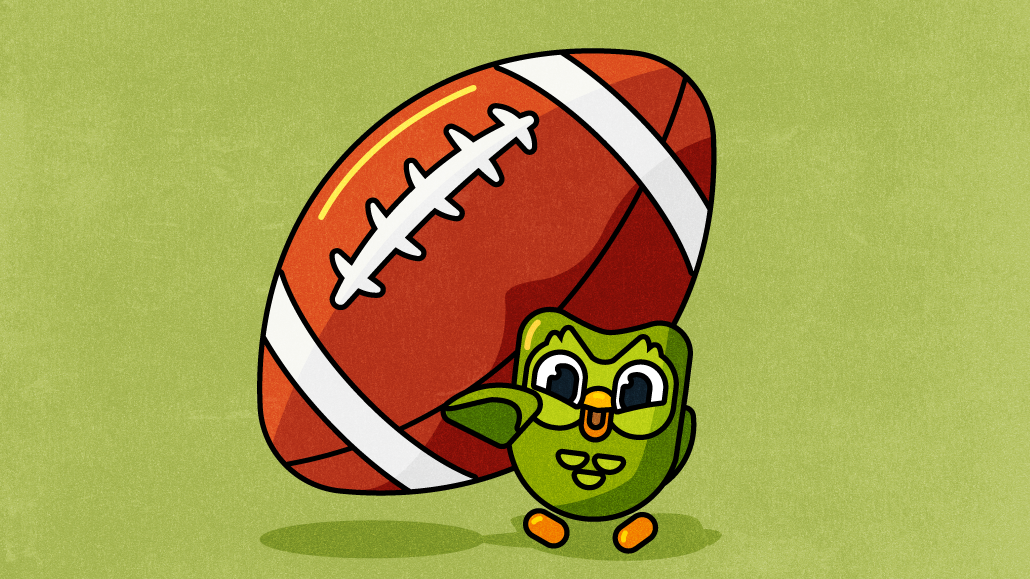Save 50% on a 3-month Digiday+ membership. Ends Dec 5.
‘It’s creativity, it’s not media budget’: How Duolingo’s CMO Manu Orssaud advertised around the Super Bowl

This story is part of Digiday’s annual coverage of the Super Bowl. More from the series →
Duolingo’s infamously irreverent big green bird took its talents to the next level, appearing in the language-learning app’s first-ever regional Super Bowl commercial on Sunday. It’s Duolingo’s biggest ad moment to date, in terms of efforts, and a play to establish itself as a credible brand in the language-learning space, according to Duolingo’s CMO, Manu Orssaud.
The five-second spot aired regionally in New York, Los Angeles, San Francisco, Pittsburgh as well as Chicago, Miami, and Detroit, followed by a push notification reminding about 4 million Duolingo users to do their lesson.
Per Orssaud, it’s a riff off of Reddit’s blip of an ad in 2021 that became one of the most talked-about (and posted-about) commercials of the day. Reddit’s play proved “you can win the Super Bowl game, the advertising game through creativity as opposed to big media buy,” he said. “That’s really why we decided to take this approach. Because that truly is our superpower — it’s creativity, it’s not media budget.”
For a brand that considers itself scrappy, relying heavily on Duo the Owl’s so-called unhingedness for viral TikTok videos, the language-learning app is seemingly taking bigger swings at traditional advertising to capitalize on cultural moments, like the Super Bowl. At the height of the Barbie movie hype last summer, marketers at Xbox, Airbnb and Bloomingdale’s were looking to cash in. Duolingo had a small cameo in the Barbie movie and to capitalize on the moment, launched an ad appearing ahead of the movie and sent Duo to the pink carpet at the Barbie premiere in Los Angeles.
Digiday caught up with Orssaud to talk about Duolingo’s Super Bowl ad premiere and growing marketing strategy.
This conversation has been lightly edited and condensed for clarity.
The Super Bowl is a big moment for the advertising industry. What made Duolingo want to show up this year?
There’s something quite unique about the Super Bowl, where it’s the only time people will really talk about the ads. They don’t have many moments during the year where there’s so much attention to what brands are doing. It feels that when you advertise in the Super Bowl, you made it as a brand.
Is that why you’re doing it?
There’s a lot of factors there that help to develop the brand stature through the Super Bowl, making sure that people see us as a credible brand. But we also feel we have the confidence to do it now because we’ve been on a journey over the last few years to really figure out what works for us as a brand and who we are as a brand. We’ve done a lot of that through that social-first approach. We take a very bottom-up approach to how we build the brand. It’s been very scrappy and experimental. We try different things and when something lands, we double down on it.
Why not just buy a 30-second ad in the Big Game as opposed to advertising around it?
It’s great to have big budgets as a marketer. But in some ways, when you have a big budget, I don’t think you push your creativity in the same way. We’ve been really successful because we’ve always had a clear sense around the fact that what makes us unique is not our ability to spend any money, but it’s our ability to actually be resourceful and work around money to go at the problem with creativity. That’s been the way we’ve been operating and that should not change with the Super Bowl.
Duolingo seems to be taking bigger swings at advertising around cultural moments. Does that mean we’ll see more traditional advertising in the future?
To us, it’s much more of a contextual strategy as opposed to a media or marketing strategy. Again, we don’t do advertising campaigns. We don’t buy TV based on a GRP (gross rating point) or the impression gained because we want to build awareness. That’s not us, that’s not how we do things. For us, it is not really buying media for the sake of reach. It’s buying media because the context, on which the media will be displayed, makes perfect sense for the idea that we have at the moment. The idea is what drives the placement as opposed to being a channel strategy.
More in Marketing

Behind the rise of the chief productivity officer and what it means for companies and employees
The CPO is envisioned as the leader who orchestrates people and technology together to drive business outcomes.

OpenX redraws the SSP-agency relationship
The gradual realignment of programmatic’s middlemen discussed at Digiday’s Programmatic Marketing Summit.

Omnicom’s reshuffled leadership emerges as the ad industry’s new power players
Omnicom’s Black Monday saw thousands of jobs cut, and a chosen few put in charge of what is now the world’s largest marketing services group. They face a number of challenges, however.







